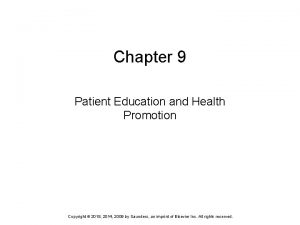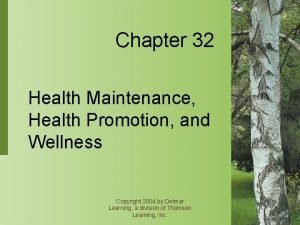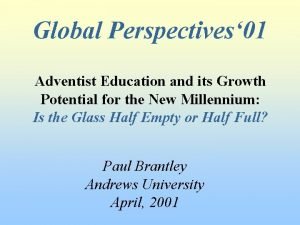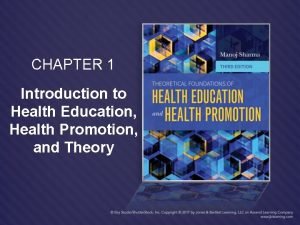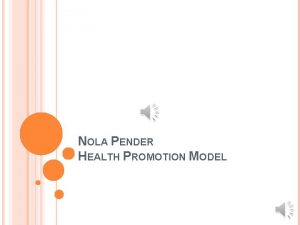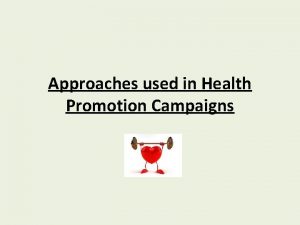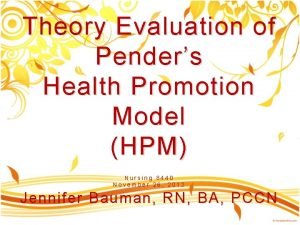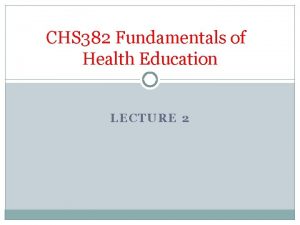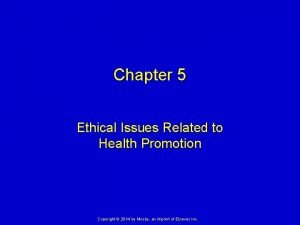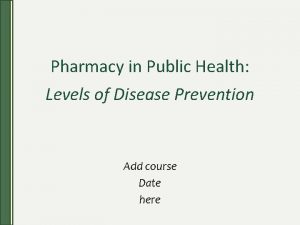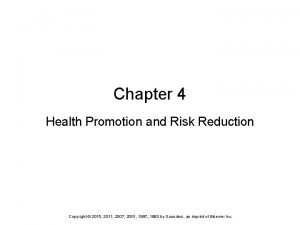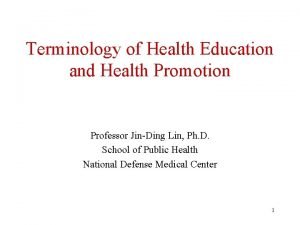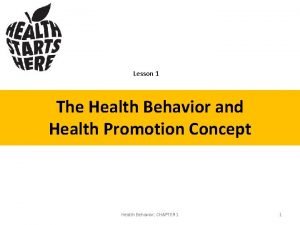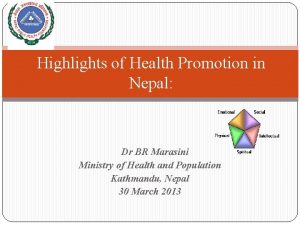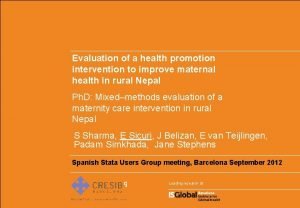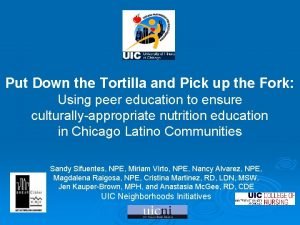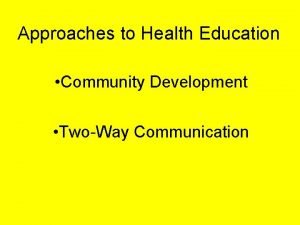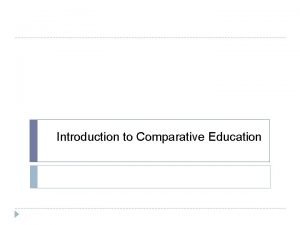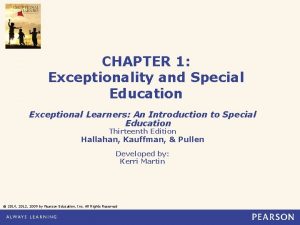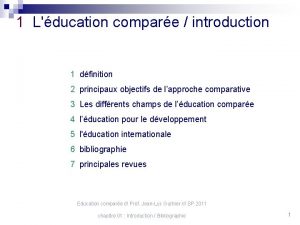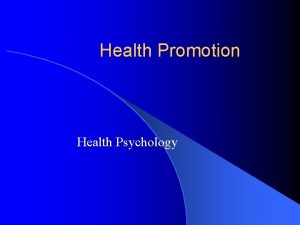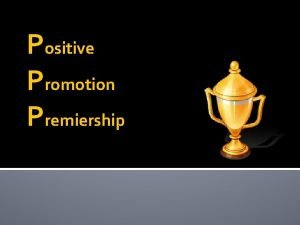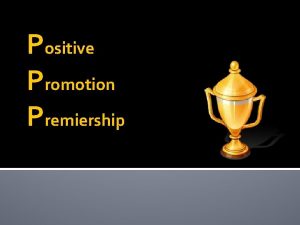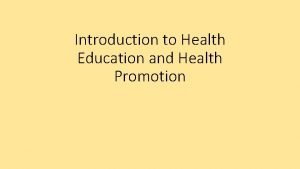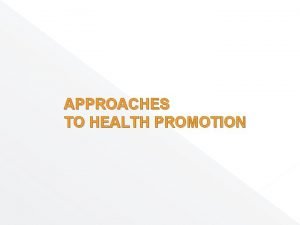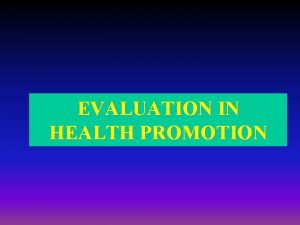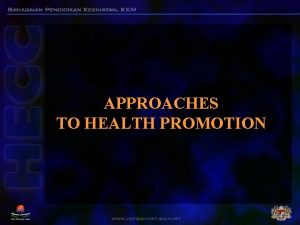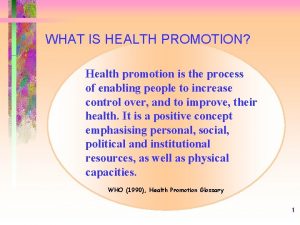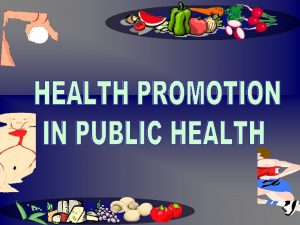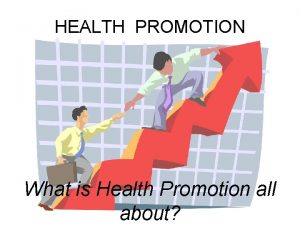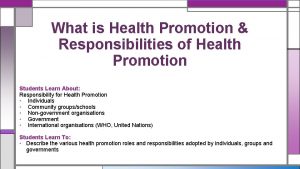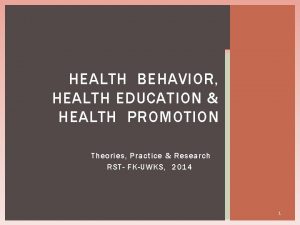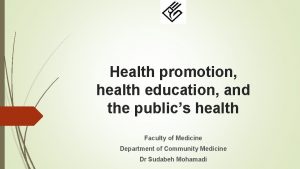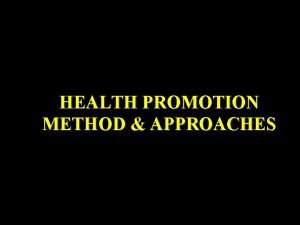CHAPTER 1 Introduction to Health Education Health Promotion









































- Slides: 41

CHAPTER 1 Introduction to Health Education, Health Promotion, and Theory

Concept of Health “Health is a state of complete physical, mental, and social well-being and not merely an absence of disease or infirmity. ” (WHO, 1945) This definition has limitations.

Limitations of the WHO Definition of Health • Dimensions inadequate - State vs. dynamic Subjective vs. objective interpretation Measurement difficult Ideal vs. achievable Means vs. end Individual vs. community orientation

Contemporary Definition of Health • A means to achieve desirable goals in life while maintaining a multidimensional (physical, mental, social, political, economic, and spiritual) equilibrium that is operationalized for individuals as well as for communities. • This definition is more inclusive Courtesy of CDC Public Health Image Library

Concept of Behavior • Any overt human action, conscious or unconscious, with measurable - Frequency Intensity Duration Levels of influence on any behavior Intrapersonal or individual factors Interpersonal factors Institutional or organizational factors Community factors Public policy factors

Health Behavior “Those personal attributes such as beliefs, expectations, motives, values, perceptions, and other cognitive elements; personality characteristics, including affective and emotional states and traits, and behavioral patterns, actions, and habits that relate to health maintenance, to health restoration, and to health improvement. ” (Gochman, 1982)

Health-Directed and Health-Related Behaviors • Health-directed behaviors are those behaviors that a person consciously pursues for health improvement or health protection, such as seeking an immunization, a physical examination, a low-fat food, or a condom. • Health-related behaviors are those actions that are performed for reasons other than health but have health effects; for example, a person trying to lose weight so he can improve his appearance.

Levels of Prevention • Primary prevention refers to those preventive actions that are taken prior to the onset of disease or an injury with a view to remove the possibility of their ever occurring. • Secondary prevention refers to actions that block the progression of an injury or disease at its incipient stage. • Tertiary prevention refers to those actions taken after the onset of disease or an injury with a view to assist diseased or disabled people.

Health Education • “Any combination of planned learning experiences based on sound theories that provide individuals, groups, and communities the opportunity to acquire information and the skills needed to make quality health decisions. ” (2000 Joint Committee on Health Education Terminology, 2002) • “Any planned combination of learning experiences designed to predispose, enable, and reinforce voluntary behavior conducive to health in individuals, groups, or communities. ” (Green & Kreuter, 2005)

Health Promotion • “Any planned combination of educational, political, regulatory, and organizational supports for actions and conditions of living conducive to the health of individuals, groups, or communities. ” (Green & Kreuter, 2005)

Ottawa Charter: Key Action Strategies • Building healthy public policy • Creating physical and social environments supportive of individual change • Strengthening community action • Developing personal skills such as an increased self-efficacy and feelings of empowerment • Reorienting health services to the population and partnership with patients

Settings for Health Education and Health Promotion • • Schools Communities Worksites Health care/patient care Consumer marketplace Media Public policy makers International/global

Who performs health education / promotion? • Health education specialists (CHES & MCHES) • Nursing educators (LPN, RN, APRN, NP) • Dietitians (RD, LD, Nutrition educator) • Health coaches • Public health professionals (CPH, MPH) • Lay health volunteers • Health care providers (MD, PA)

Areas of Responsibilities for Health Education Specialists I. Assess needs, assets and capacity for health education/promotion II. Plan health education/promotion III. Implement health education/promotion IV. Conduct evaluation and research related to health education/promotion V. Administer and manage health education/promotion VI. Serve as a health education/promotion resource person VII. Communicate, promote, and advocate for health, health education/promotion, and the profession

Evolution of Responsibilities & Competencies for CHES/MCHES • 1978: Bethesda Conference for health educators & Role Delineation Project • 1986: Second Bethesda Conference & consensus for certification • 1988: National Commission for Health Education Credentialing formed • 1989: Charter certification phase introduced

Evolution (cont’d) • 1990 to the present: NCHEC started competencybased national certification examinations • 1992: Joint Committee for the Development of Graduate-Level Preparation Standards • 1998: National Health Educator Competencies Update Project (CUP) • 2010: Health Educator Job Analysis (HEJA) project • 2011: MCHES credential started • 2015: Health Education Specialist Practice Analysis (HESPA) study

Core Functions of Public Health 1. Assessment: Regular and systematic collection, assembly, analysis, and dissemination of health information. 2. Policy development: Development of comprehensive public health policies. 3. Assurance: Ensure that services necessary to achieve agreed-upon goals in communities are provided either directly or by regulations or by other agencies.

Public Health Goals (1) (2) (3) (4) (5) Prevent epidemics and the spread of disease Protect against environmental hazards Prevent injuries Promote and encourage healthy behaviors Respond to disasters and assist communities in recovery (6) Assure the quality and accessibility of health services

Articles in the code of ethics for the health education profession • • Responsibility education • Responsibility preparation to the public to the profession to employers in the delivery of health in research & evaluation in professional

Health education organizations • American Academy of Health Behavior (AAHB) • American College Health Association (ACHA) • American Public Health Association’s (APHA) Public Health Education and Health Promotion (PHEHP) Section • American Public Health Association’s School Health Education and Services (SHES) Section • American School Health Association (ASHA)

Organizations (cont’d) • Delta Omega Honorary Society in Public Health • Directors of Health Promotion and Education (DHPE) • Eta Sigma Gamma (ESG) • SHAPE America (Society of Health & Physical Educators) • Society for Public Health Education (SOPHE)

Basic Vocabulary • Awareness: Becoming conscious of an action, object, person, or situation • Information: Gathering facts related to an action, object, person, or situation • Knowledge: Learning facts and gaining insights related to an action, object, person, or situation • Skills: Learning how to perform an action or change a situation • Health literacy: The capacity of an individual to obtain, interpret, and understand basic health information and services and the competence to use such information and services in ways that are health enhancing

Basic Vocabulary (cont’d) • Beliefs: Statements of perceived fact— impressions about the world • Attitudes: Relatively constant feelings, predispositions, or set of beliefs directed toward an object, person, or situation—beliefs with an evaluative component • Values: Enduring beliefs or systems of beliefs that a specific mode of conduct or end state of behavior is personally or socially preferable

Basic Vocabulary (cont’d) • Community mobilization: Getting community members to participate in an activity planned by an agency whose mission is to improve the status of the community in health or other matters • Community organization: Community members get organized to identify needs, set objectives, and develop plans for community improvement in health or other matters

Basic Vocabulary (cont’d) • Community participation: Involvement of the community members in planning with an agency whose mission is to improve the status of the community in health or other matters • Community development: Organizing and stimulating local initiative and leadership in a community to encourage change in health or other matters

Basic Vocabulary (cont’d) • Community empowerment: Social action process whereby individuals gain mastery over their lives in the context of changing their social and political environment Courtesy of CDC Public Health Image Library

Basic Vocabulary (cont’d) • Networking: Creating intermeshing relationships with individuals, groups, and organizations to accomplish mutually set objectives in health or other matters • Coalition building: Group of organizations in a community united to pursue a common goal related to health or other matters affecting a large number of people • Advocacy: Creating a shift in public opinion and mobilizing the necessary resources to support an issue, policy, or constituency affecting health or other matters for a large number of people

Basic Vocabulary (cont’d) • Lobbying: Influencing the policy makers to develop an issue, policy, or constituency affecting the health or other matters for a large number of people • Policy development: Developing a policy with ramifications for affecting the health or other matters for a large number of people Courtesy of CDC Public Health Image Library

Basic Vocabulary (cont’d) • Legislation: Passing a law with ramifications for affecting the health or other matters for a large number of people • Development of social norms: Creating social acceptance for a practice, behavior, condition, policy, law, or environment that may affect the health or other related matters for a large number of people

Definition of Theory “A set of interrelated concepts, definitions, and predispositions that present a systematic view of events or situations by specifying relations among variables in order to explain and predict the events or situations. ” (Kerlinger & Lee, 2000)

Generic Depiction of a Behavioral Theory Figure 1 -1: Generic depiction of a behavioral theory.

Benefits of Applying Theory • Helps in discerning measurable program outcomes • Specifies methods for behavior change • Identifies the timing for interventions • Helps in choosing the right mix of strategies • Enhances communication between professionals • Improves replication • Improves program efficiency & effectiveness

Ideal Theory • Demonstrate predictive power • Methods theories yield must be capable of effecting significant changes on affect (conation), thought (cognition), and action (volition); able to provide practical guidance on what, why, and how • Testability or ability to verify • Ability to generalize • Identify the determinants (basis); ability to explain

Commonly Used Theories in HBR • • • Health belief model Social cognitive theory Construct of self-efficacy Theory of reasoned action Theory of planned behavior Stages of change/transtheoretical model Social marketing model Diffusion of innovations Freirian model

Application Exercise • Go to your library website and see if you have access to the MEDLINE, CINAHL, and ERIC databases. If you have access, then conduct this exercise using those three databases. If not, then go to the following website, which has public domain MEDLINE (Pub. Med): http: //www. ncbi. nlm. nih. gov/sites/entrez. • Choose a health behavior of your liking, such as physical activity or eating fruits and vegetables.

Application Exercise (cont’d) • Then choose a target population, such as schoolchildren or worksite. • Using the key words “behavior, ” “target population, ” “theory, ” and “intervention, ” conduct a search for a theory-based health education or health promotion intervention. • Locate one such full-text article from your library or Internet and summarize it in 500 words.

Websites to Explore • American Public Health Association (APHA) - http: //www. apha. org/ • Eta Sigma Gamma (ESG) - http: //www. etasigmagamma. org/ • National Board of Public Health Examiners (NBPHE) - http: //www. nbphe. org/

Websites to Explore (cont’d) • National Commission for Health Education Credentialing (NCHEC) - http: //www. nchec. org/ • SHAPE America - http: //www. shapeamerica. org/ • Society For Public Health Education (SOPHE) - http: //www. sophe. org/ • World Health Organization (WHO) - http: //www. who. int/en/

Skill Building Group Activity • Through self-reflection, identify three positive health behaviors that you may be able or willing to work on during this term. • Through self-reflection, identify three negative health behaviors that you may be able or willing to work on during this term. • From the six behaviors, choose the one behavior you like most.

Skill Building (cont’d) • In a dyad, define the chosen behavior. Then identify an appropriate target group and setting for a health education or promotion program. • Using the SMART way of writing objectives shown on the next slide, write at least three program objectives that would help bring about positive change in this behavior in your target population. • Present the final version to the whole group.

Skill Building (cont’d): SMART way of writing objectives • S = Specific (what exactly is being changed and in whom) • M = Measurable (percentage of participants who will change) • A = Action verb (list, describe, identify, explain) • R = Realistic (must be achievable) • T = Time frame (end of the session, end of one year)
 Differences between health education and health promotion
Differences between health education and health promotion Chapter 9 patient education and health promotion
Chapter 9 patient education and health promotion Health maintenance and promotion
Health maintenance and promotion University of central florida health care administration
University of central florida health care administration Adventist education promotion
Adventist education promotion Introduction of health education
Introduction of health education Marketing mix introduction
Marketing mix introduction Health education and propaganda
Health education and propaganda Pengertian health promotion
Pengertian health promotion Pender's health promotion model
Pender's health promotion model Health promotion approach
Health promotion approach Approaches to health promotion
Approaches to health promotion Pender 1996
Pender 1996 Health promotion in nursing practice 7th edition
Health promotion in nursing practice 7th edition Jessica konopka
Jessica konopka Health promotion emblem
Health promotion emblem Ethical issues in health promotion
Ethical issues in health promotion Health promotion and levels of disease prevention
Health promotion and levels of disease prevention Health promotion and levels of disease prevention
Health promotion and levels of disease prevention Health promotion program in malaysia
Health promotion program in malaysia Caplan and holland model of health promotion
Caplan and holland model of health promotion Who health promotion glossary
Who health promotion glossary Ottawa charter of health promotion
Ottawa charter of health promotion Define health promotion
Define health promotion Ottawa charter emblem
Ottawa charter emblem Health promotion cycle
Health promotion cycle Chicago partnership for health promotion
Chicago partnership for health promotion The ottawa charter pdhpe
The ottawa charter pdhpe Two way method of health education
Two way method of health education Chapter 14 promotion of safety
Chapter 14 promotion of safety Introduction to health care agencies
Introduction to health care agencies Chapter 3 health wellness and health disparities
Chapter 3 health wellness and health disparities Chapter 1 understanding health and wellness lesson 2
Chapter 1 understanding health and wellness lesson 2 Chapter 1 understanding your health and wellness
Chapter 1 understanding your health and wellness Difference between als and formal education
Difference between als and formal education Backbone of extension education
Backbone of extension education Introduction of western education in india pdf
Introduction of western education in india pdf Recommendation of mudaliar commission
Recommendation of mudaliar commission Introduction of comparative education
Introduction of comparative education Exceptional learners: an introduction to special education
Exceptional learners: an introduction to special education Pédagogie comparée
Pédagogie comparée Introduction to history of education
Introduction to history of education

